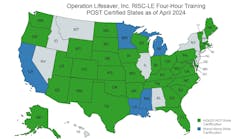Metro plans to try to keep its trains running at its aboveground stations this winter even if snow reaches 8 inches, in a change from recent years.
The transit agency also says it now has enough equipment to dedicate snowplows to each of Metros five rail lines, speeding up snow clearing around the system.
The transit agency and local officials who govern roads have tweaked their plans for handling the seasons worst after two unusually snowy and icy winters that brought many transportation systems to a halt. Metro officials plan to brief board members on their plans Thursday.
Now, 8 inches of snow is no longer an automatic trigger for shutting down aboveground rail service, spokesman Dan Stessel said.
Instead, a presentation on the plan says rail service may shut down at some of the agencys 39 aboveground stations at that level, and the rest will close when 10 inches or more accumulates. Even then, Stessel said, the agency will try to keep trains running on the Yellow Line bridge to maintain a connection between the Pentagon City and Crystal City areas with downtown D.C.
The wording has been modified to reflect that not all storms are identical and the snow does not all fall uniformly across the region, Stessel added. This allows us flexibility to be flexible.
Some storms may dump snow quickly, he said, while others may deliver a slow snowfall that plows can keep up with.
The Washington region typically doesnt get 8 inches of snowfall in a month. Over the last 30 years, the snow gauges at Ronald Reagan Washington National Airport have logged an average 14.6 inches for the entire season, with the most falling in January at 5.6 inches, according to the National Weather Service.
But the winter of 2009-2010 challenged Metro and the regions transportation officials as back-to-back storms left more than 2 feet of snow, and Metros aboveground train service was suspended for nearly an entire workweek.
The transit agency said then it needed to shut down rail service at all aboveground stations when snow reached 8 inches, because snow could get caught in the equipment, a lesson learned the hard way in 2003.
That snowstorm, plus last seasons Jan. 26 meltdown that stranded drivers on area roads for 10 or more hours, spooked other officials, too. This year, Maryland officials say they have a new tow plow that trails behind snow plows to get the center lane. And they are asking Snow Squad volunteer drivers to report on snow conditions. Virginia officials say they have added $20 million to their snow removal budget to reach $126 million, even though the amount spent the past two years was well over $200 million. And the District has outfitted snowplows and salt trucks with new locators to monitor the vehicles and where theyve been.
Still, the new plans may not get much use. This coming winter, according to the federal Climate Prediction Center, the region is expected to have normal precipitation and slightly warmer than average temperatures.
Copyright 2008 LexisNexis, a division of Reed Elsevier Inc. All rights reserved.
Terms and Conditions | Privacy Policy


